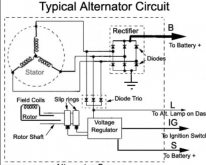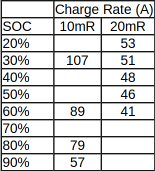Bzzzt
New Member
- Joined
- Jun 17, 2020
- Messages
- 34
The battery is a 240Ah unit made up of 120Ah cell pairs (2p4s)? I wanted some redundancy! I suspect the alternator has protection BUT the voltage at the van battery has been more or less constant during charging, so the alternator has not entered any protection mode.Thank you bzzt. Do you mind to share the size of your battery LFP bank? 280ah? do you know if your alternator is temp regulated? I've read that almost all of them are; so it could be the alternator limiting the current on high temp. I just found one alternator from Leece-Neville that is: "High Temperature rated to 125oC with No throttle-back regulator, maintains output at high temperatures" and continous duty at 12,000rpm (alt rpm). Trying to figure out what the limit on current is cause if it is not going to charge more than 80A most of the time no need to though more money at it lol. Thank you!
The one time I saw 160 amps was after drawing the lifepo4 down to 12 volts. This is lower than I normally go! The voltage at the cells rose quite rapidly and the current dropped to the 80-100 amp range for the duration of the charge.
I recently added the 10mR resistor to the system just because I don't need to charge so quickly and with summer coming up I thought it would be nicer to the alternator. That said, I can easily bypass the resistor for higher charge rates (or if it's -30 and I am not worried about the alternator overheating!).
It is hard to find hard numbers out there to support or debunk direct charging! I went with the direct connection based on a single bit of 'internet evidence' suggesting that below 300Ah you probably don't need to throttle. Unfortunately I failed to collect data with the base setup (bad coding). I will post the charge rate data that I collect with the resistor (~20mR TOTAL resistance) since this question keeps coming up.




